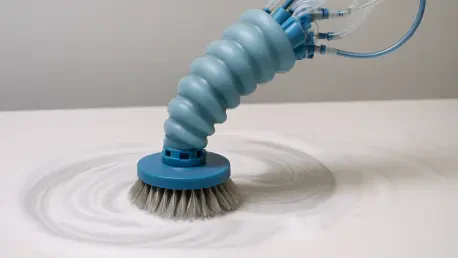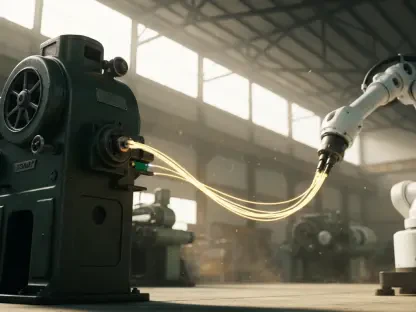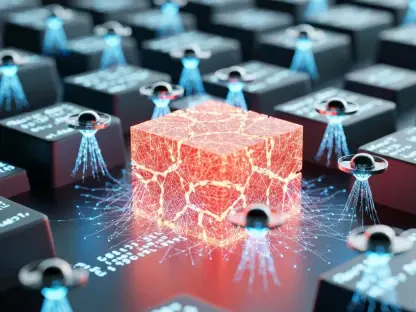What if the tedious chore of scrubbing stubborn grease off a kitchen stove or erasing grime from bathroom tiles could be effortlessly delegated to a robot? Imagine a device that not only tackles these messy tasks with precision but does so safely alongside humans, transforming the way we approach household cleaning. This scenario is no longer a distant dream, thanks to a groundbreaking innovation from researchers at Northeastern University. A soft robotic arm known as SCCRUB is stepping into the spotlight, promising to redefine how household cleaning is approached with cutting-edge technology.
A New Era of Clean: Can Robots Scrub Away the Grind?
The daily grind of household chores often feels like an endless cycle, with scrubbing surfaces ranking among the most dreaded tasks. Unlike vacuuming, which has seen robotic solutions gain traction, scrubbing requires a unique blend of force and finesse that most machines struggle to achieve. SCCRUB, short for Surface Cleaning Compliant Robot Utilizing Bristles, emerges as a potential game-changer, designed to handle tough messes that typically demand elbow grease.
This innovation isn’t merely about convenience; it’s about reclaiming time in a fast-paced world. With households juggling work, family, and personal pursuits, the idea of a robot taking on labor-intensive cleaning sparks intrigue. Could this be the dawn of a new era where technology lifts the burden of mundane tasks, allowing more focus on what truly matters?
Why Household Automation Is a Growing Necessity
The push for automation in homes reflects a broader societal shift toward efficiency and balance. As schedules grow tighter, the physical and mental toll of chores like scrubbing becomes more apparent, often leading to frustration or neglect. Statistics reveal that the average American spends over six hours weekly on housework, with surface cleaning eating up a significant chunk of that time.
Beyond time constraints, repetitive tasks can strain the body, causing fatigue or even injury over time. The rise of robotic vacuums has eased some burdens, yet many areas of cleaning remain untouched by automation. SCCRUB targets this gap, addressing a need that resonates with millions seeking smarter ways to maintain their living spaces.
Unveiling SCCRUB: The Power of Soft Robotics in Action
At the heart of this innovation lies SCCRUB, a soft robotic arm engineered for safety and effectiveness. Unlike traditional rigid robots, its flexible design ensures it can operate near humans without posing risks, while still delivering the strength needed to scrub away tough residue. In controlled tests, it removed over 99% of grime from surfaces like glass plates coated with dried ketchup and toilet seats smeared with blueberry preserves.
The robot’s brilliance is in its components: a counter-rotating scrubber brush stabilizes pressure during cleaning, while torsionally rigid universal couplings, known as TRUNC cells, allow the arm to bend and extend with drill-like torque. Paired with a deep learning-based software controller, SCCRUB adapts to various surfaces, ensuring precision in every motion. This combination of flexibility and power sets it apart as a pioneer in domestic robotics.
Its lightweight build further enhances its appeal for home use. The focus on human-safe interaction means it could one day scrub a countertop while someone prepares dinner nearby. This balance of innovation and practicality positions the technology as a potential household staple, ready to tackle messes that have long defied automation.
Expert Perspectives: Validating a Cleaning Revolution
Lead researchers Jeffrey Lipton and Jakub F. Kowalewski from Northeastern University describe SCCRUB as a step toward eliminating “dull and dirty” chores from daily life. Lipton highlights the robot’s ability to merge power with safety, a critical factor for consumer acceptance. “The goal is to create tools that work seamlessly in human spaces,” he notes, emphasizing the design’s intent to fit into everyday environments.
Kowalewski envisions broader applications, suggesting that soft robotic arms like this could extend beyond homes to other settings needing safe, effective automation. Experimental results bolster their confidence, with the robot’s performance in real-world scenarios underscoring its potential. Such expert insights lend credibility to the notion that this technology could reshape how cleaning is perceived and performed.
The emphasis on safety as a core principle aligns with industry standards for human-robot interaction. As the research team continues to refine the system, their findings point to a future where such innovations could become as commonplace as other household gadgets, trusted for both efficacy and security.
Bringing SCCRUB into Homes: Steps Toward Everyday Use
While still in the research phase, the pathway to integrating SCCRUB into households is taking shape with clear, practical strategies. Initial focus could center on high-mess zones like kitchens and bathrooms, where intense scrubbing is often required. Tailoring the robot for these specific areas would maximize its immediate impact on daily routines.
Developing user-friendly interfaces, such as smartphone apps for customizing cleaning patterns, could simplify operation for all ages. Rigorous testing in diverse home settings remains essential to ensure safe interactions around families and pets, building trust in the technology. Additionally, expanding its capabilities with adaptable attachments might allow it to handle tasks beyond scrubbing, such as wiping or rinsing surfaces.
Scalability is another consideration, with potential to refine production costs and accessibility over time. Collaboration with manufacturers could accelerate its journey from lab to living room, making automated cleaning a reality for a wider audience. These steps outline a roadmap for transforming an innovative concept into an indispensable tool for modern living.
Reflecting on a Cleaner Past, Building a Smarter Tomorrow
Looking back, the journey of SCCRUB stands as a testament to human ingenuity, blending soft robotics with the mundane to create something extraordinary. Its development marked a pivotal moment when technology began to shoulder the weight of household drudgery, offering a glimpse of relief for countless individuals. The success in early tests and the vision of researchers paint a picture of what has been achieved—a robot that scrubs with precision and safety.
Moving forward, the focus shifts to actionable progress, with an emphasis on refining this technology for broader adoption. Partnerships between academia and industry could drive faster integration into homes, while continued innovation might expand the robot’s role in daily life. The challenge remains to ensure affordability and accessibility, so that the benefits of automated cleaning reach beyond a select few, paving the way for a future where time is reclaimed for joy rather than toil.









